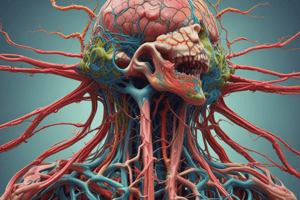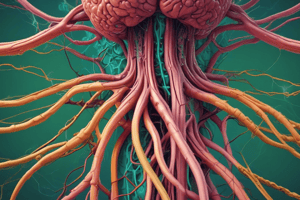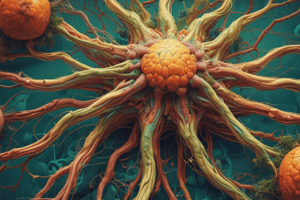Podcast
Questions and Answers
Where do B cells develop?
Where do B cells develop?
- Spleen
- Yellow bone marrow
- Red bone marrow (correct)
- Thymus
What is the role of T cells in the immune response?
What is the role of T cells in the immune response?
- Contain cell killing granules
- Store energy as fat in yellow bone marrow
- Differentiate into plasma cells
- Secrete chemokines to bring other immune cells to the area (correct)
Which immune cell type is considered the first line of defense against viruses and some cancers?
Which immune cell type is considered the first line of defense against viruses and some cancers?
- Natural Killer cells (correct)
- Plasma cells
- T cells
- B cells
Where do T cells mature?
Where do T cells mature?
What do plasma cells primarily secrete?
What do plasma cells primarily secrete?
Where are germinal centers located in the body?
Where are germinal centers located in the body?
What is the main function of lymph nodes?
What is the main function of lymph nodes?
What is the role of dendritic cells in lymph nodes?
What is the role of dendritic cells in lymph nodes?
Where is mucosa-associated lymphoid tissue (MALT) found?
Where is mucosa-associated lymphoid tissue (MALT) found?
Why might tonsils be removed in some cases?
Why might tonsils be removed in some cases?
What characterizes lymphoid nodules?
What characterizes lymphoid nodules?
What is the primary function of the lymphatic system?
What is the primary function of the lymphatic system?
Where do all leukocytes (white blood cells) originate?
Where do all leukocytes (white blood cells) originate?
Which of the following is NOT a function of lymphocytes?
Which of the following is NOT a function of lymphocytes?
How does lymph move through the lymphatic vessels?
How does lymph move through the lymphatic vessels?
Which of the following areas of the body does NOT have lymph vessels?
Which of the following areas of the body does NOT have lymph vessels?
What is the primary function of B cells?
What is the primary function of B cells?
Which type of immune response is slower to develop but highly specific and effective against a wide variety of pathogens?
Which type of immune response is slower to develop but highly specific and effective against a wide variety of pathogens?
What is the function of natural killer cells in the immune system?
What is the function of natural killer cells in the immune system?
Which protein-digesting enzyme enters infected cells and triggers apoptosis?
Which protein-digesting enzyme enters infected cells and triggers apoptosis?
What is the role of opsonization in the immune system?
What is the role of opsonization in the immune system?
Which cells respond to an injured area by releasing histamine, leukotrienes, and prostaglandins?
Which cells respond to an injured area by releasing histamine, leukotrienes, and prostaglandins?
What is the primary function of T cells in the immune system?
What is the primary function of T cells in the immune system?
Which region of T cells is specific for binding to a single particular antigen?
Which region of T cells is specific for binding to a single particular antigen?
'Carb antigen' typically refers to antigens found in which type of pathogens?
'Carb antigen' typically refers to antigens found in which type of pathogens?
What is the main function of a pattern recognition receptor in the immune system?
What is the main function of a pattern recognition receptor in the immune system?
What differentiates macrophages from monocytes in the immune system?
What differentiates macrophages from monocytes in the immune system?
Which type of cell is responsible for presenting antigen to T cells and stimulating the immune response?
Which type of cell is responsible for presenting antigen to T cells and stimulating the immune response?
What is the main role of helper T cells in the immune response?
What is the main role of helper T cells in the immune response?
What is the purpose of the negative selection process during T cell development in the thymus?
What is the purpose of the negative selection process during T cell development in the thymus?
What is the main difference between the primary and secondary immune responses?
What is the main difference between the primary and secondary immune responses?
What is the primary function of IgA antibodies?
What is the primary function of IgA antibodies?
What is the main role of regulatory T cells in the immune system?
What is the main role of regulatory T cells in the immune system?
What is the primary mechanism by which cytotoxic T cells kill target cells?
What is the primary mechanism by which cytotoxic T cells kill target cells?
What is the main difference between active and passive immunity?
What is the main difference between active and passive immunity?
How do fungal infections differ from bacterial infections in terms of the immune response?
How do fungal infections differ from bacterial infections in terms of the immune response?
What is the purpose of the process of clonal selection during the T cell immune response?
What is the purpose of the process of clonal selection during the T cell immune response?




